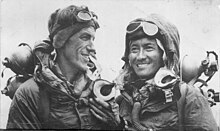
High altitude breathing apparatus is a breathing apparatus which allows a person to breathe more effectively at an altitude where the partial pressure of oxygen in the ambient atmospheric air is insufficient for the task or to sustain consciousness or human life over the long or short term.
High altitude breathing sets may be classified by type in several ways:
- by application: aviation breathing apparatus and mountaineering breathing apparatus.
- by breathing gas source: self-contained gas supply, or remotely supplied gas,
- by breathing circuit type: open, semi-closed, or closed circuit,
- by gas supply type: constant flow, supply on demand, or supplemental,
- by ventilatory driving force: the breathing effort of the user, or mechanical work from an external source,
- by gas mixture: air, oxygen enriched, or pure oxygen.
The user respiratory interface is the delivery system by which the breathing apparatus guides the breathing gas flow to and from the user. Some form of facepiece, hood or helmet is usual.
Any given unit is a member of several types.